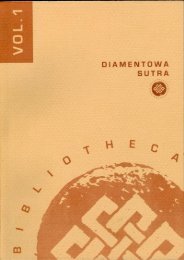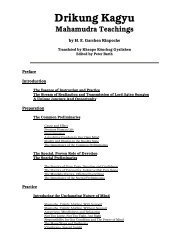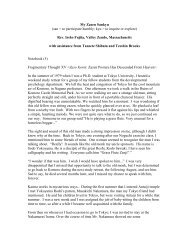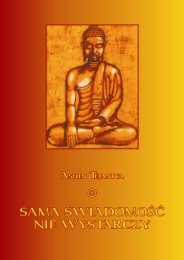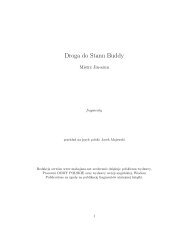3 - Computing in the Humanities and Social Sciences
3 - Computing in the Humanities and Social Sciences
3 - Computing in the Humanities and Social Sciences
You also want an ePaper? Increase the reach of your titles
YUMPU automatically turns print PDFs into web optimized ePapers that Google loves.
absence of a material representation <strong>the</strong> ascetic can visualize <strong>the</strong> deity <strong>in</strong> meditation (see<br />
for example Yamasaki 1988, <strong>in</strong> particular pp. 154-162).<br />
In addition, Staal cont<strong>in</strong>ues, “mantras need not have an effect, or a visible effect”<br />
(Staal 1989: 69). In this case to counter Staal we could easily refer to Lévy-Strauss <strong>and</strong><br />
his pr<strong>in</strong>ciple of “symbolic efficacy.” But Staal’s statement is <strong>in</strong> contrast with <strong>the</strong><br />
assumptions of esoteric rituals. Rituals, <strong>in</strong> addition to <strong>in</strong>duc<strong>in</strong>g <strong>in</strong> <strong>the</strong> ascetic altered<br />
states of consciousness, whose effect on <strong>the</strong> radiation emitted by <strong>the</strong> bra<strong>in</strong> is measurable<br />
(Fischer 1981: 286-305)), have <strong>the</strong> power to transform “a mundane sett<strong>in</strong>g <strong>in</strong>to a<br />
precisely <strong>and</strong> m<strong>in</strong>utely conceived replica of a sacred cosmos” (Wheelock 1989: 102). We<br />
could also add that esoteric exegetes such as Kakuban emphasize that even though <strong>the</strong><br />
practitioner is not aware of hav<strong>in</strong>g atta<strong>in</strong>ed <strong>the</strong> siddhi (<strong>the</strong> f<strong>in</strong>al goal of esoteric rituals),<br />
that does not mean that <strong>the</strong> goal has not been achieved. In o<strong>the</strong>r words, atta<strong>in</strong>ment is<br />
always automatic <strong>and</strong> necessary, <strong>in</strong>dependently of <strong>the</strong> awareness (or lack <strong>the</strong>reof) of <strong>the</strong><br />
practitioner. 23<br />
As a conclusion of this discussion, we could say that objections to <strong>the</strong> application<br />
of <strong>the</strong> speech acts <strong>the</strong>ory to mantras arise from a narrow <strong>and</strong> dogmatic def<strong>in</strong>ition of that<br />
<strong>the</strong>ory. But if we employ that <strong>the</strong>ory heuristically <strong>in</strong> a field that was not orig<strong>in</strong>ally<br />
considered by Aust<strong>in</strong>, that of mantric expressions, we need to exp<strong>and</strong> it to be able to<br />
address o<strong>the</strong>r issues that are specific to <strong>the</strong> mantric usage. In particular, we should take<br />
as our start<strong>in</strong>g po<strong>in</strong>t an “emic” perspective, <strong>in</strong>ternal to <strong>the</strong> tradition we study.<br />
Accord<strong>in</strong>gly, mantras are not idle utterances, mere flatus vocis, but effective <strong>in</strong>teractions<br />
with deities. In particular, <strong>in</strong> ritual mantras do not describe or represent reality; <strong>the</strong>y are<br />
used to address <strong>the</strong> deities <strong>in</strong> a performative way <strong>in</strong> order to produce, l<strong>in</strong>guistically,<br />
23 A short text attributed to Kakuban, entitled Matsudai sh<strong>in</strong>gon gyoja yoj<strong>in</strong> (“Precautions for <strong>the</strong><br />
Sh<strong>in</strong>gon practitioner <strong>in</strong> <strong>the</strong> f<strong>in</strong>al age of Dharma”), is very significant <strong>and</strong> explicit <strong>in</strong> this respect. Here is<br />
<strong>the</strong> <strong>in</strong>tegral translation:<br />
“Precautions for <strong>the</strong> Sh<strong>in</strong>gon practitioner <strong>in</strong> <strong>the</strong> f<strong>in</strong>al age of Dharma”<br />
(as <strong>in</strong> accordance with <strong>the</strong> explanations <strong>in</strong> <strong>the</strong> scriptures)<br />
[Question:] Does <strong>the</strong> one who arises <strong>the</strong> desire for enlightenment (bodaish<strong>in</strong>) necessarily atta<strong>in</strong> <strong>the</strong> siddhi?<br />
[Reply:] Yes, <strong>the</strong> person with deep faith atta<strong>in</strong>s <strong>the</strong> siddhi. [Q.:] What do you mean exactly? [R.:] Even<br />
though after long practices one cannot see <strong>the</strong> results, one should not give <strong>in</strong> to doubt, one should not<br />
give up. The one who holds forth will certa<strong>in</strong>ly atta<strong>in</strong> <strong>the</strong> siddhi. The ma<strong>in</strong> deity of a ritual (honzon), <strong>in</strong><br />
order to test <strong>the</strong> ascetic, or <strong>the</strong> various deities, <strong>in</strong> order to test <strong>the</strong> depth of <strong>the</strong> ascetic’s faith, may prevent<br />
him/her [from atta<strong>in</strong><strong>in</strong>g <strong>the</strong> expected result]. It may also happen that, because of serious karmic<br />
impediments, <strong>the</strong> ascetic th<strong>in</strong>ks he/she has not succeeded. However, he/she has really atta<strong>in</strong>ed <strong>the</strong> siddhi,<br />
but he/she is not aware of it. Fur<strong>the</strong>rmore, demons can also create impediments <strong>and</strong> hide (<strong>the</strong> atta<strong>in</strong>ment<br />
of) <strong>the</strong> result. S<strong>in</strong>ce (<strong>the</strong> apparent failure to atta<strong>in</strong> <strong>the</strong> siddhi) could be due to one of <strong>the</strong>se factors, one<br />
should not give <strong>in</strong> to doubt. (<strong>in</strong> Miyasaka 1989, ed.: 2/64-65).<br />
40



![Shushogi, Dogen Zenji [PDF] - Mahajana.net](https://img.yumpu.com/50921105/1/190x219/shushogi-dogen-zenji-pdf-mahajananet.jpg?quality=85)


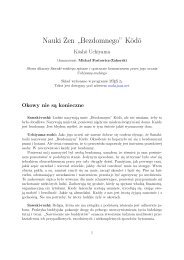

![wywiadu z Murakami Kosho Roshim [PDF] - Buddyzm w Polsce i na ...](https://img.yumpu.com/45809746/1/184x260/wywiadu-z-murakami-kosho-roshim-pdf-buddyzm-w-polsce-i-na-.jpg?quality=85)
